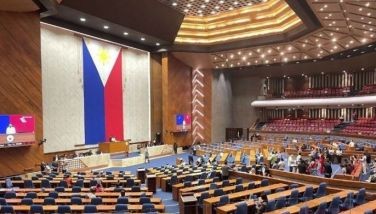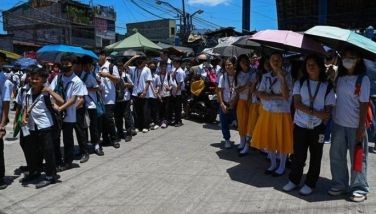Zero tolerance on EDSA
MANILA, Philippines – The Philippine Natinal Police-Highway Patrol Group (HPG) will adopt a “zero tolerance policy” in dealing with erring motorists as it takes over traffic management on EDSA beginning today.
HPG spokesman Chief Inspector Oliver Tanseco said zero tolerance would be implemented on all types of motorists, including those with special protocol plates.
Tanseco warned drivers against showing off business cards of VIPs while being cited for traffic violations.
He also warned drivers against assaulting HPG troopers, reminding them that they are policemen.
“HPG troopers will not hesitate to disable a vehicle by shooting its tire in case a motorist escapes from a crime,” Tanseco told dzBB.
He also warned that any motorist trying to bribe an HPG officer would be arrested and charged with a criminal offense.
The HPG will take over traffic management from the Metropolitan Manila Development Authority (MMDA) in the effort to contain the chaotic traffic situation along the 23.8-kilometer EDSA.
In 1995, traffic management duties on EDSA were transferred from the HPG to the MMDA as the HPG focused on anti-crime operations on the highways.
The worsening traffic along EDSA, however, triggered an outcry among motorists and commuters that prompted the government to act.
Authorities have identified the so-called choke points along EDSA that heavily contributed to traffic congestion.
PNP spokesman Chief Superintendent Wilben Mayor said 150 troopers would be deployed in six major choke points – EDSA corner Taft Avenue, Guadalupe, Shaw Boulevard, Ortigas, Cubao, and Balintawak.
Mayor said PNP chief Director General Ricardo Marquez would personally lead the sendoff of HPG troops for deployment along EDSA.
Mayor said the 150 HPG policemen would be accompanied by 180 traffic personnel from the MMDA.
HPG director Chief Supt. Arnold Gunnacao said they saw the need to add more HPG troops after a dry run a few days ago.
HPG officers were tasked to strictly follow the 30-second rule to wrap up all apprehensions.
Tanseco explained the rule is to get the license of the offending driver then issue the traffic citation ticket, all within 30 seconds.
This is to prevent the erring motorist from trying to talk his or her way out, which usually ends in bribing the arresting officer.
Tanseco said the 30-second rule would apply to all motorists, whether driving a private vehicle or a passenger bus.
MMDA chairman Francis Tolentino said the HPG takeover is part of the all-out government approach in confronting the worsening traffic along EDSA.
Aside from the HPG, the Department of the Interior and Local Government (DILG), Land Transportation Office (LTO), Land Transportation Franchising and Regulatory Board (LTFRB) were tasked to help control the traffic situation along EDSA.
Tolentino said the DILG was tasked by the President to instruct local government units in Metro Manila to clear all traffic obstructions in their localities, particularly street vendors occupying major roads.
The Department of Public Works and Highways (DPWH), for their part, will be putting up signage and markers in key areas and provide engineering work to help LGUs clear major roads.
The DPWH has identified key areas targeted for clearing operations.
Among these roads is the stretch of Taft Avenue in Pasay City that has been closed to traffic after vendors occupied the street for several years.
The LTO and LTFRB, on the other hand, will help the HPG in apprehending erring drivers, charging them according to nature of their violation.
The LTFRB said soutbound provincial buses would be banned from EDSA during morning rush hour beginning today.
LTFRB board member Ariel Inton said provincial buses bound for Batangas, Laguna, Bicol and Visayas coming from their terminals in Cubao and Kamuning will take P. Tuazon, C-5, and then proceed to the South Luzon Expressway (SLEX) from 6 a.m. to 9 a.m. from Monday to Friday, except weekends and holidays.
He said provincial buses could use EDSA from 9:00 a.m. onwards.
Inton added they would also strictly implement the yellow lanes along EDSA for passenger buses except for private vehicles turning left or right to exit.
As the HPG takes over the EDSA traffic situation, the MMDA would still be responsible over Roxas Boulevard, C-3 Road, and other major thoroughfares in Metro Manila.
The HPG officers at each choke point would be assisted by two other police officers coming from the local police precinct.
The HPG officers deployed at each choke point would have motorcycles and patrol cars.
Each HPG officer would be carrying traffic violation tickets issued both by the MMDA and the LTO. The tickets issued by the LTO carry higher fines for traffic violations as stated under the Joint Administrative Order 2014-01.
The apprehending HPG officer has the discretion which sort of ticket to issue after taking note of the gravity of the traffic violation.
However, a different rule would be enforced if the erring motorist bribes the apprehending HPG officer.
The PNP had warned any attempt to bribe the HPG officer is a criminal offense punishable with six years to 12 years imprisonment.
Long term solution urged
Lawmakers said the deployment of HPG troops along EDSA would not solve the traffic problem.
While deployment of enforcers from the HPG will help ease traffic along EDSA, the government has to have a long-term solution to the worsening congestion, Valenzuela City Rep. Sherwin Gatchalian said.
He said Malacañang should create a super body to impose a unified and coordinated traffic scheme in Metro Manila that will have operational control over several agencies.
“Cities in Metro Manila implement different policies to manage the vehicular flow in their respective areas but this only worsens the overall traffic in Metro Manila. There should be a traffic czar whose well-coordinated traffic plan will be followed in all cities,” Gatchalian said.
He said the super body will be headed by a “traffic czar” with Cabinet rank and also have operational control over franchises for public transportation, including the Metro Rail Transit (MRT) and the Light Rail Transit (LRT), as well as the enforcement of traffic laws.
The traffic czar’s agency will act as the clearinghouse of all activities on the road, including road works by DPWH and the Metropolitan Waterworks and Sewerage System (MWSS).
The Management Association of the Philippines (MAP) earlier called for the appointment of Cabinet Secretary Jose Rene Almendras as traffic czar.
Malacañang said there is no need to appoint a traffic czar but the traffic woes are being tackled at Cabinet level in coordination with concerned sectors.
Quezon City Rep. Winston Castelo said aside from appointing a traffic czar, the government could heed the recommendations of the House of Representatives committee on Metro Manila development based on numerous public hearings and consultations.
Among the recommendations are an honest-to-goodness bus rationalization in Metro Manila; immediate completion of flagship road infrastructure and mass transport projects like the railway and subway systems; strict implementation of traffic laws;
identification by local chief executives of secondary roads and their clearance of road obstructions; the implementation of four-day, 10-hour work schedule in select businesses and government offices; scrapping of “boundary system” in public utility vehicles, and swift removal of “colorum” public utility vehicles. – Cecille Suerte Felipe, Paolo Romero
- Latest
- Trending


























